

Zeiss Axio Examiner – fixed-stage flexibility
The Zeiss Axio Examiner is a top-quality research microscope designed to meet the toughest demands when it comes to flexibility and performance. With four upper bodies and two lower bodies on a fixed stage, a large variety of additional modules and motorisation options, users can build a configuration that fits their individual requirements – from a pure transmitted-light stand to the most demanding laser scanning system.
Using our LM digital adapters, a camera can be attached to the 30mm eyepiece tube or the photo tube quickly and easily. DSLR and system cameras are ideally suited for microscopy. They can be controlled from a computer and deliver excellent image quality. We will be happy to advise you when selecting the right digital camera for your specific needs.
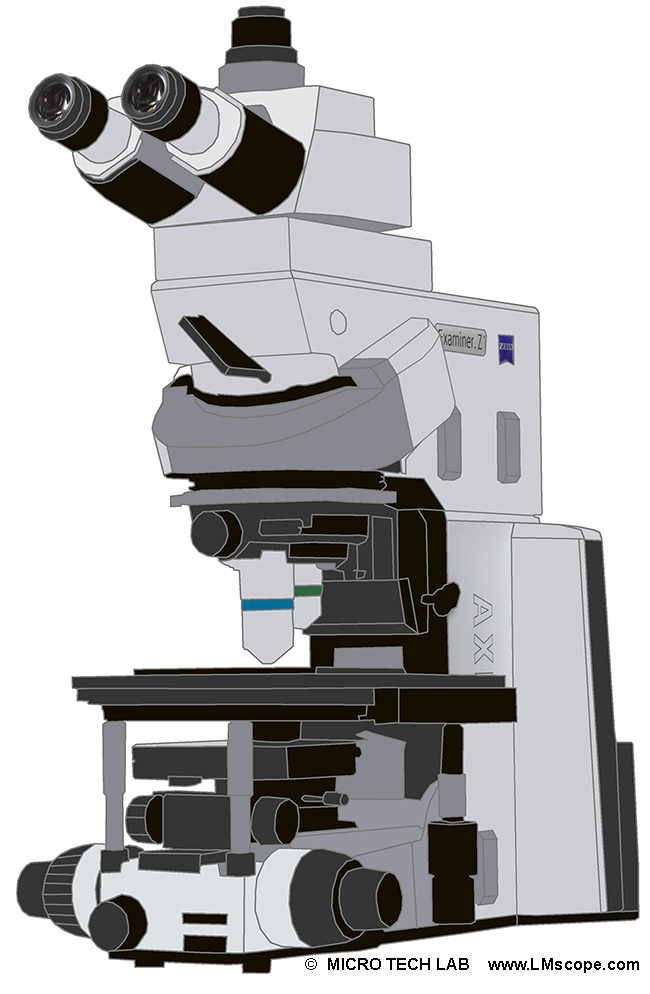
The Axio Examiner.A1 is equipped with either a manual or motorised lower body and has an objective parfocal length of 45mm. The Axio Examiner.D1 and Axio Examiner.Z1 stand versions feature an innovative reflector turret and have a specialised optical concept. The Axio Examiner.D1 is available in either a manual or motorised version, while the high-end Axio Examiner.Z1 has an optional motorised upper body with side port coupling in the infinity space and a motorised lower body. The motorised components are designed for minimum vibration and automatically switch off upon reaching their target position to avoid electrical disturbance effects.
For us, the two camera ports – located on the microscope head and at the side port – are especially important. With our LM digital adapters, users can either attach same-brand cameras or standard DSLR and system cameras of their choice to the microscope. Because all our adapters are excellently built and have a plan-achromatic optical system, the image quality that can be attained with these cameras is outstanding. High resolution, exceptional focus and remarkable colour contrasts are enough to win over any user.
Mounting on the binocular ergonomic photo port Art.Nr.425521.9050.000:
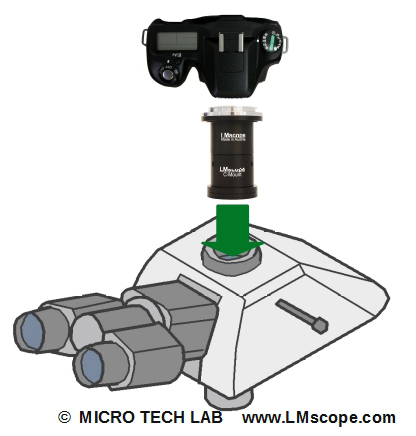
Further types of tubes:
1.) Binocular photo tube Art.Nr. 425520.9020.000
2.) Binocular photo tube Art.Nr. 425520.9030.000
3.) Binocular photo tube Art.Nr. 425503.9901.000
4.) Binocular photo tube Art.Nr. 425521.9020.000
5.) Binocular photo tube Art.Nr. 425521.9000.000
6.) Binocular photo tube Art.Nr. 425521.9040.000
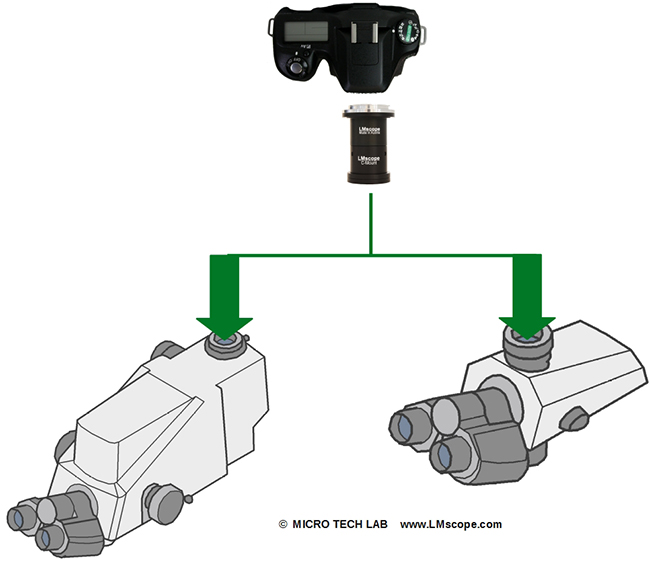
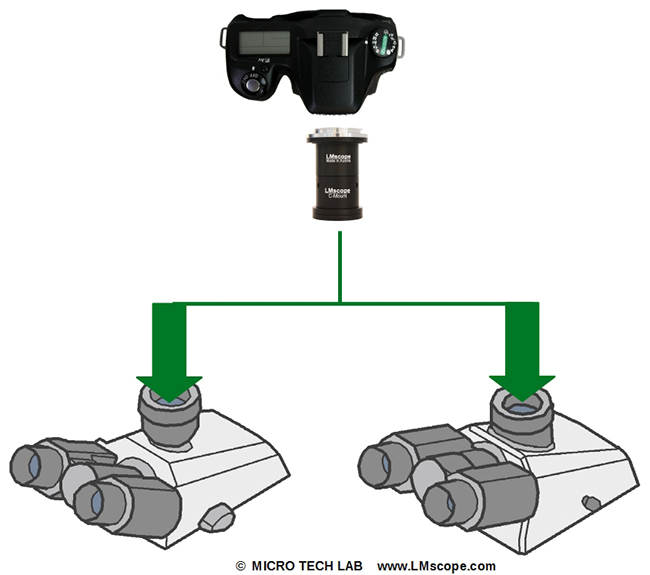
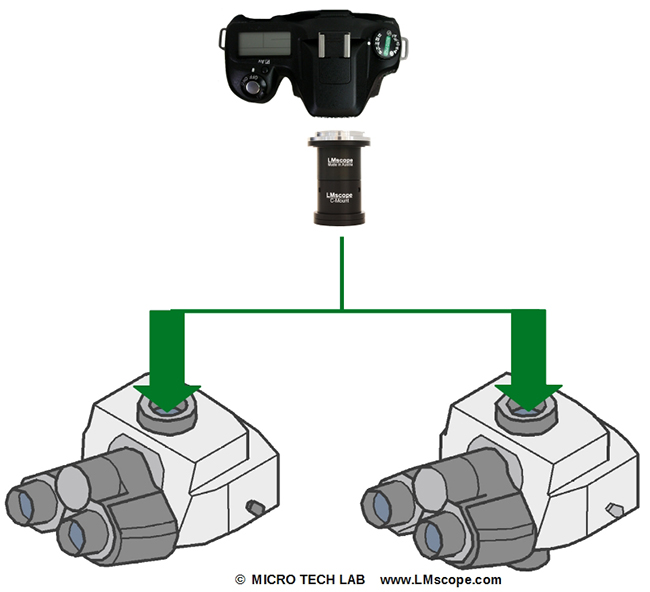
In addition, the Axio Examiner.Z1 has a side port coupling in the infinity space for the dual camera system described below.
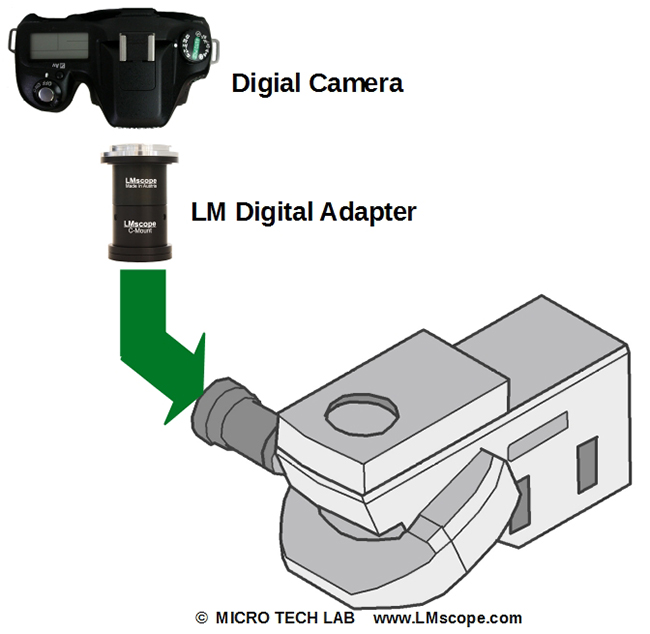
Depending on the specific requirements, users can chose among an interchangeable objective turret with 1, 2 or 4 positions. For large specimens, the stage and condenser carrier can be removed or a spacer can be inserted. All relevant control elements are located at the front and are therefore easily accessible. The motorised version can also be controlled via a docking station with touchscreen and the AxioVision software.
The Axio Examiner offers all major contrasting techniques for both visible or infrared light: simple oblique illumination, differential interference contrast (DIC) and Dodt gradient contrast (a special segment diaphragm that reduces the diffused light fraction in the specimen is combined with a diffusion screen).
A number of different condensers with stationary front optics and almost fully enclosed housing accommodate the different specimens.
The proven ICS optics system from Carl Zeiss is available for the Axio Examiner.A1. For the larger members of the Axio Examiner family, the Axio Examiner.D1 and the Axio Examiner.Z1, this optical concept has been extended and further improved to meet the demanding requirements of all transmitted light and reflected light applications. Two objective series are available: the cost-effective W N-ACHROPLAN series and the high-end W Plan-APOCHROMAT series. Objectives with a parfocal length of 75mm can be used as an alternative for the standard 45mm versions. Three solutions are available for changing the magnification independently of the objective:
- Push&Click optovar modules in the reflector turret apply both to the eyepiece image and the camera image with factors of 1.25x, 1.6x and 2.5x.
- 4-position magnification changer turret with 5 different magnification factors.
- Zoom tube for infinitely variable magnification options for two camera ports with identical image positions; the upper port is adjustable in x, y and z. In conjunction with the Push&Click module, IR-DIC and fluorescence channels can be imaged simultaneously.
Two different laser scanning systems for confocal microscopy are available; a detailed description can be found on the Zeiss website.
The AxioVision microscopy software includes a very interesting feature: the Dual Camera module allows the synchronous operation of two structurally identical cameras. This makes it possible to double the recording speed while guaranteeing perfect synchronisation, especially in the case of very rapid processes.
Photography:
Fitting the microscope to digital single-lens reflex (DSLR), mirrorless interchangeable-lens cameras (MILC ), digital single-lens mirrorless (DSLM) or C-mount cameras is easy with our LM digital SLR adapters, which feature a plan achromatic optical system. Our products make it possible to capture top-quality microscope images. To help you select the adapter that is right for your camera, we have set up an online configurator on our website. You can also email us – ideally with attached photographs of your microscope.
Modern DSLR and single-lens mirrorless (DSLM) offer the latest technology and are generally very well suited for microscopy applications. Most of them can be controlled remotely via PC/Mac. Because of their high sales volumes, they offer an excellent price/performance ratio compared to special-purpose microscope cameras.
Features of top DSLR and single-lens mirrorless cameras (DSLM):
- Large, powerful full-frame sensors (36 x 24 mm)
- Sensor resolution of 61 megapixels or 240 megapixels with Pixel Shift technology
- High light sensitivity (ISO 400,000+)
- Extensive dynamic range (up to 15 aperture stops/f-stops)
- Short exposure times (1/8000 second) up to 1/32,000 seconds using the digital shutter
- 4K Ultra HD or 8K Ultra HD video function
- Live video capture on external monitors in ultra HD quality
In most cases, these cameras are significantly more powerful than microscope cameras with smaller sensors (1/2" or 2/3"). On our website you will find our current camera recommendations and a camera ranking which is specifically tailored to microscopy applications.
New LM Digital Adapter for: Sony Alpha 9 III / Nikon Z9 / Nikon Z8 / Sony Alpha 7R V / Sony Alpha 1 II / Sony Alpha 1 / Sony Alpha 9 II (ILCE-9M2) / Sony FX3 Cinema Line / Sony Alpha 9 / Nikon D6 / Canon EOS R3 / Canon EOS R6 Mark II / Canon EOS R8 / Sony Alpha 7R IV / Canon EOS R5 II / Nikon Z6III / Canon EOS R5 / Sony Alpha 7S II / Sony Alpha 7S III / Sony Alpha 7R III / Canon EOS R6 / Nikon Z6 / Nikon Z6II / Sony Alpha 7R II / Nikon Z7 / Nikon Z7II / Canon EOS R / Canon EOS Ra (Astro) / Nikon Z5 / Sony Alpha 7C / Canon EOS RP / Sony Alpha 7S / Canon EOS R7 / Leica SL2-S / Canon EOS R10 / Nikon Z50 II / Canon EOS 1D X Mark III / Nikon Z50 / Nikon Z30 / Nikon Z fc / Nikon D850 / Canon EOS 1D X Mark II / Nikon D780 / Olympus OM-1 / Sony Alpha 7III / Olympus OM-D E-M1 Mark III / Canon EOS R100 / Sony Alpha 6700 / Nikon D5 / Sony Alpha 6600 / Fujifilm X-H2S / Fujifilm X-S10 / Fujifilm X-E4 / Fujifilm X-Pro3 / Olympus OM-D E-M1X / Sony Alpha 6400 / Sony Alpha 6100 / Sony ZV-E10 / Canon EOS 1D X / Nikon D4s / Olympus OM-D E-M5 III / Canon EOS 90D / Canon EOS 5D Mark IV / Nikon D4 / Nikon D750 / Canon EOS 6D Mark II / Fujifilm X-T5 / Fujifilm X-T4 / Fujifilm X-T3 / Sony Alpha 6300 / Sony Alpha 6500 / Nikon D500 / Nikon D810 / Nikon D800 / Canon EOS M6 Mark II / Nikon D800E / Nikon Df / Panasonic Lumix DC-G9 / Nikon D610 / Nikon D600 / Canon EOS 250D / Canon EOS 850D / Rebel T8i / Canon EOS 6D / Sony Alpha 99 II (SLT-A99 II) / Canon EOS M200 / Canon EOS 5DS R ( without low-pass filter) / Olympus OM-D E-M1 Mark II / Canon EOS 80D / Canon EOS M50 Mark II / Canon EOS 5DS / Canon EOS M50 / Sony Alpha 77 II / Canon EOS 70D / Nikon D7200 / Pentax K-1 Mark II / Canon EOS 200D / Canon EOS 800D / Rebel T7i / Canon EOS 77D / Canon EOS 5D Mark III / Canon EOS 60D / Sony Alpha 7R /